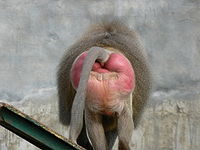
Callosity
Encyclopedia

Callus
A callus is an especially toughened area of skin which has become relatively thick and hard in response to repeated friction, pressure, or other irritation. Rubbing that is too frequent or forceful will cause blisters rather than allow calluses to form. Since repeated contact is required, calluses...
, a piece of skin
Skin
-Dermis:The dermis is the layer of skin beneath the epidermis that consists of connective tissue and cushions the body from stress and strain. The dermis is tightly connected to the epidermis by a basement membrane. It also harbors many Mechanoreceptors that provide the sense of touch and heat...
that has become thickened as a result of repeated contact and friction.
Monkeys
When occurring on an animal's buttocks, as with baboonBaboon
Baboons are African and Arabian Old World monkeys belonging to the genus Papio, part of the subfamily Cercopithecinae. There are five species, which are some of the largest non-hominoid members of the primate order; only the mandrill and the drill are larger...
s, they are specifically called ischial callosities. They enable the monkeys to sleep sitting upright on thin branches, beyond reach of predators, without falling.
The ischial callosities are one of the most distinctive pelvic features which separates Old World monkey
Old World monkey
The Old World monkeys or Cercopithecidae are a group of primates, falling in the superfamily Cercopithecoidea in the clade Catarrhini. The Old World monkeys are native to Africa and Asia today, inhabiting a range of environments from tropical rain forest to savanna, shrubland and mountainous...
s from New World monkey
New World monkey
New World monkeys are the five families of primates that are found in Central and South America: Callitrichidae, Cebidae, Aotidae, Pitheciidae, and Atelidae. The five families are ranked together as the Platyrrhini parvorder and the Ceboidea superfamily, which are essentially synonymous since...
s.
Right whales
Otherwise, the word callosity is generally reserved for describing the calluses found on the head of the three species of right whaleRight whale
Right whales are three species of large baleen whales consisting of two genera in the family Balaenidae of order Cetacea. Their bodies are very dark gray or black and rotund....
s.
Callosities are a characteristic feature of the Eubalaena genus of whales; because they are found on the head of the whale and appear white against the dark background of the whale's skin, they make it very easy to identify these species. The callosities themselves are grey; the white appearance is due to large colonies of whale lice around them. Callosities arise naturally and are present even in late-term whale fetuses, although the work of lice digging into the surface of the skin may make them more jagged and hard over time.
The evolutionary purpose of callosities is unknown. Male right whales have a higher density of callosities than females. Males have been observed scratching one another with their callosities, so they may play a role in sexual selection. This explanation is not entirely satisfactory, as it does not account for the appearance of callosities in females.
Callosities form a unique pattern on every right whale. This makes them an extremely useful tool for the purposes of photo-identification and conservation.

